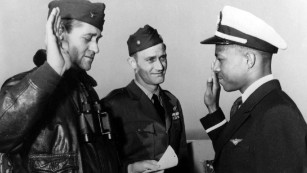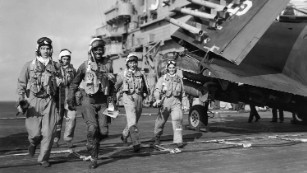Jesse Leroy Brown was a racial pioneer. The son of a sharecropper, Brown as a youngster working in Mississippi’s corn and cotton field, would declare whenever he saw an airplane overhead that he was going to be a pilot one day.
After World War II, Brown would make good on his childhood dreams, becoming the first African-American Navy pilot. He did that at the time the military was still segregated.
Born on October 13, 1926, in Hattiesburg, Mississippi, Brown grew up dead poor as a sharecropper’s son. After graduating second in his class from Eureka High School in 1944, Brown set out on a journey to challenge America’s racial divide.
Brown rejected the suggestion that he attend traditionally black university and enrolled at Ohio State University which then was predominantly white. Brown studied engineering at Ohio State University from 1944 to 1947.
According to History Net, Brown became the only black student enrolled in the University’s College of Engineering that fall. To survive America’s economic inequality, Brown worked part-time as a janitor at a department store while engaging in boxcar loading during the night shift for the Pennsylvania Railroad.

Bent on making good on his childhood dreams and fantasies of being a pilot one day, Brown, after seeing a poster announcing a new Navy flight training program, rushed to the recruiting office and declared desire to enroll.
The program was called V-5.
The recruiting officer, one Lt. Dawkins, according to reports, told Brown he wouldn’t be able to pass the written exam, adding that even if he did, there was no way he would ever get to sit in a Navy cockpit since there had never been a black Navy aviator.
With so much confidence and an insatiable desire to accomplish what he always dreamed of, Brown unequivocally replied to the recruiting officer he would like to be the first – the first to sit in a Navy cockpit – thus becoming a racial pioneer.
Naturally gifted scholarly, Brown passed the written exams as well as the physical test, enlisting into the U.S. Navy Reserves on July 8, 1946. Brown properly joined the Navy in 1947 as an aviation cadet.
According to the Navy Times, Brown’s classmates unremittingly harassed him, using every cruel tactic they could imagine to force him to resign. Even the black stewards in the mess hall were offended by his presence.
Brown attended pre-flight school in Ottumwa, Iowa, and moved to Pensacola and Jacksonville, Florida after that to attend flight school. He became the first African American to earn his Navy wings in 1948, despite what the Acepilots web site called “racist resistance to an African-American studying aeronautics and aviation.”
Out of 100 candidates to enter the aviation program at Pensacola, Brown was one of only six men who completed it on October 21, 1948, eight days after he turned 22.
Brown would then be assigned to fighter squadron VF-32 aboard the light carrier Wright (CVL-49). His squadron transferred to the fleet carrier Leyte (CV-32) in October of 1950, which joined Fast Carrier Task Force 77, on its way to assist United Nations forces in Korea.

According to Navy Times, Brown flew a Vought F4U-4 Corsair, providing air support for allied ground troops. His section would then head to the Chosin Reservoir to support the embattled U.N. troops there on December 4, 1950.
Flying over the North Korean countryside 17 miles behind enemy lines in his Corsair fighter, Brown discovered that he was hit.
“I think I may have been hit,” Brown announced over the radio. “I’ve lost my oil pressure.”
“Losing power,” Brown radioed to his squadron. “My engine is seizing up.”
Spotting a small mountain clearing, Brown made a move to crash land.
The fuselage reportedly buckled at the cockpit, and the instrument panel slammed into his right leg, trapping him.
Brown’s fellow wingman, Lt. Tom Hudner, witnessed what Brown was going through, and decided to do something risky; he was also going to crash land into the same mountain clearing to rescue Brown.

“I’m going in,” he said over the radio as his plane dived toward Brown’s smoking Corsair.
Hudner then made a move belly-landing his own plane about 100 yards from the downed Corsair. Realizing he could not free his squadron mate, Hudner radioed for a rescue helicopter, but by that time Brown was fading fast from loss of blood and the frigid temperatures on the mountain.
Brown would die in the process. He was given a “warrior’s funeral” after unanimously agreeing that sending a team to recover Brown’s body was impractical due to the proximity of enemy troops.
Hudner received the first Navy Medal of Honor of the Korean War for his efforts to save Brown (who was awarded a posthumous Distinguished Flying Cross).
For many, Brown’s story goes deeper than racial inspiration. As John Blake said in an article on CNN, Brown’s story “is also about the importance of being able to see yourself in someone who doesn’t look like you”










